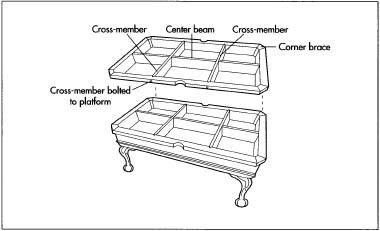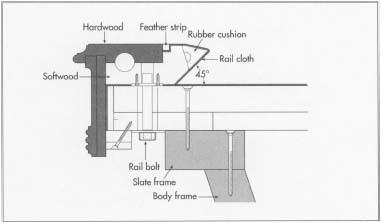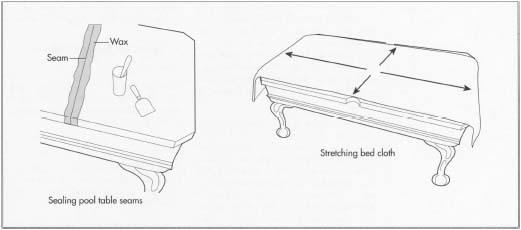Pool Table
Background
In pool (the common American term for pocket billiards), a ball is struck with the end of a long, slender stick (cue), causing it to roll into other balls and knock them into holes (pockets) around the edges of the playing table. A short wall (rail) around the perimeter of the table keeps the balls on the playing surface. The rail is faced with a rubber cushion so balls that strike it rebound predictably and remain in play.
In the United States, the game's governing body is the Billiards Congress of America (BCA). One of the BCA's functions is to define specifications for equipment acceptable for sanctioned tournaments. Although it does not specify the exact size of an approved pool table, the BCA requires that its playing surface be twice as long as it is wide. BCA specifications for the table include maximum allowable surface deflections under a specified vertical force, surface flatness tolerances, size and shape requirements for the rubber cushion and the pockets, and composition requirements for the playing surface and its cloth covering.
History
The origin of billiard tables is uncertain. The most common theory is that around the fifteenth century, tables were used in France and England for an indoor version of a lawn game similar to croquet. A ball (bille in French) resting on the table was shoved with a stick (billart in French), in order to propel the ball through a wire gate to strike a wooden peg. The function of six pockets around the edges of the table is unclear. Vertical walls (banks in English) around the edges kept balls from falling off the table. The first recorded billiard table was one sold to King Louis XI of France in 1470.
Billiards developed simultaneously in England. The rules varied from place to place, as described in The Complete Gamester, a book published in England in 1674. By this time, the club-shaped billart had evolved into a slender cue. It took another century for the wire gate and upright wooden peg to gradually disappear from billiard tables. Because playing surfaces were made of wood, they had a tendency to warp. As players began to purposely rebound balls off the table's edge walls, builders began to pad the banks with cloth stuffed with horsehair or rags.
During the 1700s, billiards remained popular in France and England, and caught on in the United States. Table sizes varied, but the 2:1 ratio of length to width became standard. Rails were padded with tightly rolled cloth, producing a somewhat more predictable ball rebound.
The Industrial Revolution contributed to a series of improvements in billiard tables. Between 1800 and 1850, chalk was first used on cue stick ends to increase friction, leather cue tips were invented, diamond-shaped sights were added to rails, slate was introduced as a superior table surface, and vulcanized rubber (which maintained its properties regardless of temperature fluctuations) was quickly adapted for rail cushions.
Subsequent refinements in pool tables have related primarily to construction techniques. For example, in older tables horizontal holes were drilled in the slate edges and filled with molten lead; screws running through the vertical edge of the rail were tightened into the lead-lined hole. In contrast, rails are

Raw Materials
Although some inexpensive pool tables use synthetic slate or plastic honeycomb sheets, the preferred playing surface (and the only one sanctioned by the BCA) is natural slate. It is quite dense, with the amount in a typical table weighing 450 lb (200 kg) or more. This mass helps keep the table stationary during play. Italian slate has long been the preferred type, but Brazilian slate now has some proponents.
Slate is prepared at the quarry, where computer-controlled, diamond-blade saws are used in conjunction with laser measuring devices to cut it into very flat sheets 0.75-1 in (1.9-2.5 cm) thick. The slate sheets are shipped in sets of three panels, which are certified as having been cut from the same slab. Three-section table surfaces are preferred because the smaller sections are lighter and safer to lift, less prone to break, and easier to level during installation. Prior to shipment, properly sized holes are drilled in the slate for the pockets and for the bolts and screws that will be used to attach the slate to the table and rails.
The other major component of pool tables is wood. Usually at least two types are used. Poplar (tulipwood), a hardwood with superior self-healing properties that holds screws tightly and recovers well when staples are removed, is preferred for the structural framework of the table. Other hardwoods that provide a more attractive finish and are more resistant to nicks and scratches are used for the outer surfaces of the table. Examples are oak, maple, and mahogany.
Rails are usually produced by laminating two types of wood-an attractive, durable hardwood for the upper section and a functional softwood (like pine) or poplar for the lower section. Grade-A vulcanized rubber is preferred for the rail cushions, which are shaped to a particular triangular profile approved by the BCA. Canvas fabric is molded to the top and base of the cushion for proper rebound performance and secure attachment to the rail.
The cloth used to cover the slate and the rails is designed specifically for pool tables. By BCA edict, it must be primarily wool; available wool/nylon blends range from 100%/0% to 60%/40%. Although it is often

Small components are made from various materials. Slate-sealing wax is specially formulated for this purpose, and is harder than beeswax. Diamond- or circular-shaped sights embedded in the rail tops are usually made of mother of pearl, abalone shell, or plastic. Pocket irons may be made of cast iron, zinc alloy, aluminum, rubber, or high-impact styrene plastic. Traditionally, pocket liners are made of leather (solid or net), but plastic or rubber is also used. Some tables use ball return ramps formed of materials such as polyethylene, aluminum, or heavy-gauge wire; they may be lined with rubber.
The Manufacturing Process
Construction techniques vary among manufacturers. The following description represents a generic process rather than an accurate account of a particular manufacturer's methods.
Preparation of components
- 1 Edge liners made of 0.75-in (2-cm) thick 1 × 8-in (1.9 × 18-cm, finished size) and 1 × 4-in (1.9 × 9-cm, finished) lumber are glued to the bottom of the slate around the edges. The wider strips are placed under the edges where pockets will be located. Until the wood glue is dry, the liners are clamped securely to the slate.
- 2 Following the pocket cutouts in the slate, pockets are sawed through the liner. Bolt and screw holes for attaching the rails and the table body are drilled in the liner to match the precut holes in the slate.
- 3 Sides for the body frame are cut from 2 × 12-in (4 × 28-cm, finished) lumber. Corners and top edges of the four sides must be carefully cut because once assembled, they will slope inward at a 15° angle from top to bottom. The frame is made smaller than the slate, so the slate overlaps the frame by 3.5 in (9 cm) on each side of the table. The sides are glued and nailed or screwed together.
- 4 Legs are prepared for the table. Solid wood pieces may be carved in decorative shapes, or hollow legs can be built by assembling wood sheets in a box shape. Wooden leg supports are glued and screwed into each corner of the frame.
-
5 A slate frame is built on the top edges of the body frame. Strips of
1.5 × 3-in (4 × 8-cm) wood are attached so they overhang the
body frame by about I in (2.5 cm), except at the corners. Two cross
members made from 2 × 6-in (4 × 14-cm, finished) lumber are
glued and screwed between the long sides of the slate frame to support
the
slate seams. A longitudinal support may be installed along the center of the frame, between the short sides. Pocket holes are cut in the corners and long sides of the slate frame.
 Once the seams are sealed on the pool table frame, the bed cloth is stretched tightly over the frame and secured.
Once the seams are sealed on the pool table frame, the bed cloth is stretched tightly over the frame and secured. - 6 Lower and upper rail components are sawed from appropriate woods. They are glued together to make six laminated sections 1.75 in (4.5 cm) thick and long enough to fit between each successive pair of pockets. The face angles on the rail are cut precisely for proper positioning of the rubber cushion. A groove is cut along the top edge to accept an anchoring strip for the cloth that will ultimately cover the rail.
- 7 Circular-or diamond-shaped sights are carefully placed at three locations on each rail section.
- 8 An apron (also called a blind) section about 4 in (10 cm) wide is cut to match the length of each rail section. This component will cover the ends of the slate and liner, slate frame, and body frame.
- 9 Each component is stained, fine sanded, and finished with catalyzed vamish, lacquer, and/or furniture wax. Rubber cushions are glued to the rail sections.
Assembly of components
Pool tables are usually shipped in pieces and assembled during installation of the table at the purchaser's location.
- 10 Legs are bolted to the underside of the table body. The structure is checked for level, and shims are inserted between the legs and the body if necessary.
- 11 The three sections of slate are screwed into place atop the table body. Shims may be placed as needed under the slate liners to ensure a flat, level surface. The seams between the three slate sections are sealed with hot wax, with any residue being carefully removed from the top surface.
- 12 Cloth is stretched tightly and uniformly across the slate, with the edges wrapped over the slate liner and stapled to its edges. Rail faces are also covered with cloth.
- 13 The rail sections are joined by inserting the pins of the pocket irons into holes drilled in the ends of each rail section. Bolts inserted upward through the slate are used to secure the rail atop the slate. Care must be taken to ensure that the sections are installed straight and tight. Pocket liners or ball return ramps are attached.
- 14 Blinds are glued and screwed to the bottoms of the rails and the edges of the slate liner.
Quality Control
Major manufacturers cut wooden components with computer-controlled equipment to ensure precision. They assemble the pieces of each table by hand at the factory, checking for proper fit before disassembling them for shipment. An installer, employed by the dealer rather than the manufacturer, reassembles the pieces at the purchaser's location. The quality of the manufacturing operation and of the installation process are both important for proper performance of the table.
Materials used in the table affect the quality, appearance, and cost of the table. An inexpensive table, for example, might have particle board components that do not hold screws or staples as well as solid wood. Tables vary widely in quality and cost; a casual player who wants a table for a few years of personal recreation can get one for around $600. So-called popularly priced tables, which are well-built, durable, and attractive, may cost $1,600-$3,000.
The Future
The use of alternative materials continues to be explored. Aiming for durability and stability, for example, one manufacturer recently introduced a pool table with a frame made of steel and rails formed of tempered aluminum. The metals are covered with a decorative synthetic veneer. The slate-topped table weighs 1,050 lb (480 kg), about the same as a wooden table. The manufacturer claims the table meets BCA specifications.
Where to Learn More
Periodicals
Bowman, Paul M. "Building a Pool Table." Fine Woodworking (March/April 1989). http://www.bestbilliard.com/resources/buildtable.cfm . (May 31, 2000).
Other
BCA Equipment Specifications. Billiards Congress of America. http://www.bestbilliard.com/resources/specs.htm (January 6, 2000).
Gandy Pool Tables. http://gandys.com (May 31,2000).
DiPaolo, Dennis. "Pool Table Buyer's Guide." http://www.seasonalstores.com/guide.html (May 31, 2000).
Best Billiard Sales and Service. http://www.bestbilliard.com (March 24, 2000).
SAM Billiards. http://www.billaressam.com (June 3, 2000).
— Loretta Hall
Comment about this article, ask questions, or add new information about this topic: